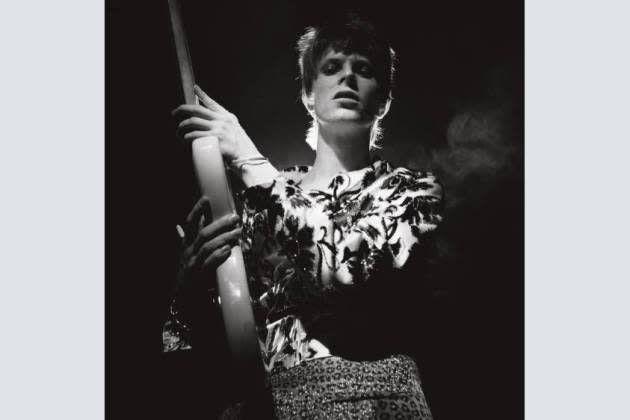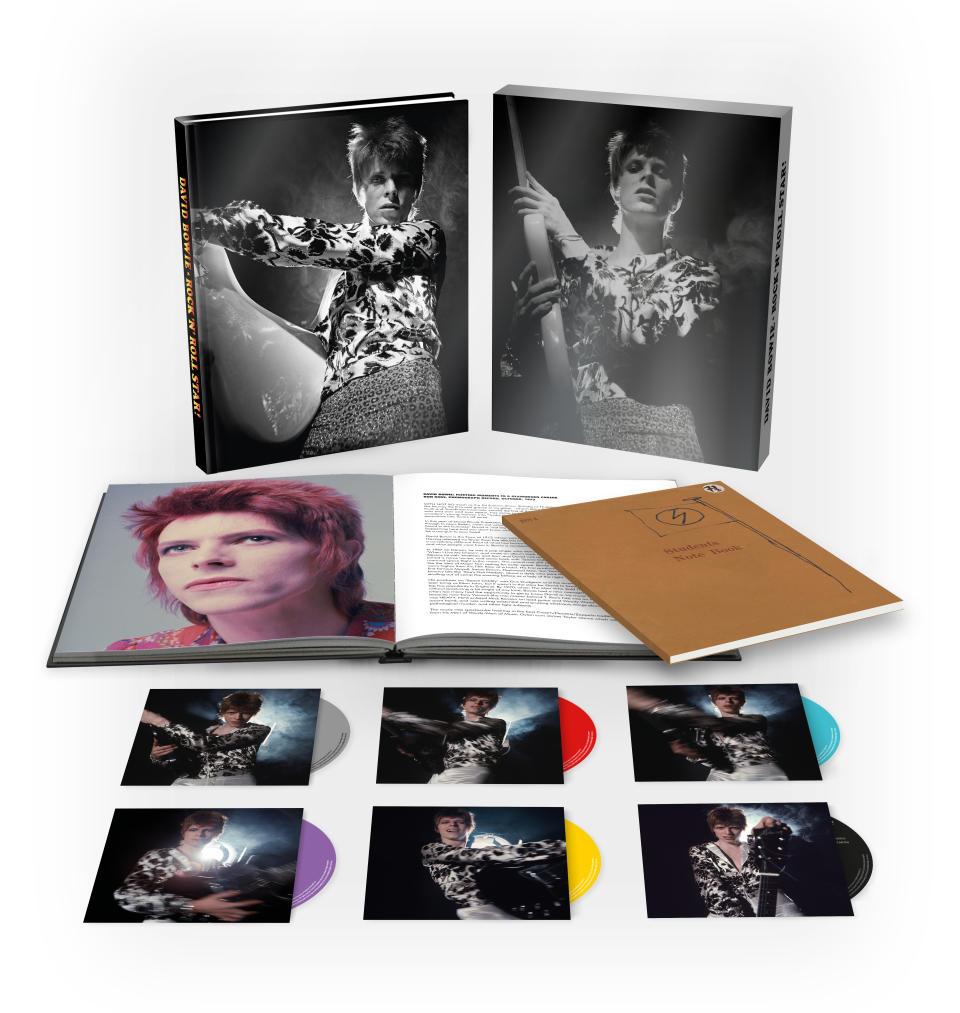Hear the Creation of David Bowie’s Iconic ‘Ziggy Stardust,’ Step by Step, in New 5-CD ‘Rock and Roll Star’ Boxed Set: Album Review

It’s probably safe to assume that anyone who clicked on this article already knows the context of David Bowie’s culture-shifting 1972 album “The Rise and Fall of Ziggy Stardust and the Spiders From Mars,” which is indisputably one of the greatest and most influential albums of the rock era. If not, play the album immediately, click here and here — and save “Rock and Roll Star,” the sprawling new 5-CD, superfan’s-dream-come-true boxed set, for when you inevitably become a superfan yourself, because this definitely is not the place to start your relationship with the album.
This latest in the Bowie estate’s stellar series of archival releases includes basically everything Bowie recorded around the classic album except the classic album itself. And for die-hards, there are several dreams-come-true in the set’s 67 tracks (with even more on a Blu-Ray disc), which continue the high standards of previous releases from the estate — beautifully remixed or remastered sound, great packaging and best of all, a gorgeous 112-page book filled with photos, liner notes, and new and old articles that amounts to the definitive record of the making of the album.
More from Variety
Bowie’s brilliant 1971-1980 hot streak — one of the greatest bursts of creativity in contemporary music history — began in 1971 with the “Hunky Dory” album and soared into the stratosphere with “Ziggy,” the loosely told tale of the titular fictional rock star whose persona Bowie co-opted and rode to superstardom. It was recorded just weeks after its predecessor but, as we see here in great detail, had been marinating in its creator’s mind for quite some time. As with the similar boxes around Bowie’s three preceding albums, we’re led through the creation of the album as it progressed from rough demos and sketches into rehearsals, recording the album, then into then radio sessions and live recordings.
Much of the material here has been released officially or bootlegged over the decades, but a lot of it hasn’t — so we’ll get right to the most exciting tracks, which don’t appear until disc 5, billed “Outtakes and Alternative Versions,” and were newly remixed and otherwise tidied-up by Bowie’s co-producer of the original album, veteran Beatles engineer Ken Scott.

Bowie and his band — guitarist/arranger Mick Ronson, drummer Mick Woodmansey and bassist Trevor Bolder — were a well-oiled machine by the time of the late ’71-early ’72 album sessions, and the fiery versions of Bowie’s best “Ziggy Stardust”-era outtakes — “Velvet Goldmine,” “Sweet Head,” lively re-recordings of his earlier songs “Holy Holy” and “The Supermen,” and covers of songs by the Velvet Underground, Chuck Berry and Jacques Brel — were first officially released as B-sides or on archival collections decades ago. But Bowie guarded his archives zealously, and there are several other castoff original compositions from the album sessions that few people had previously heard: songs with tantalizing titles like “Shadow Man,” “Looking for a Friend,” “It’s Gonna Rain Again,” “Only One Paper Left,” “Blackhole Kids” and “Something Happens,” perhaps others as well At long last, here are the “Ziggy” session versions of the first-named three of them, along with much tighter mix of “Sweet Head” that, with just a little more work, actually could have fit in on the original album.
“Sweet Head” is the real winner here — although it is clearly not a final take (and has been available for many years), Scott’s new revamp is much punchier than the previously released version and sheds better light on the lyrics, which are a missing piece of the album’s storyline and are filled with sexually loaded boasts from the Ziggy Stardust character: “So bob your sweet head/ Brother Ziggy’s gonna play/ I’m just about the best you can hear/ Gonna rock it in your head/ Shazam and kapow!/ With my guitar and my soprano/ We can give you sweet head.” Like “Velvet Goldmine,” the song is filled with NSFW lines that would have been problematic in 1972, which was at least one reason why both of those songs were dropped from album contention early.
Nearly as strong is the updated take on “Looking for a Friend,” a mid-tempo rocker reminiscent of “Song for Bob Dylan” from “Hunky Dory,” which had been recorded earlier in more hippie-fied versions but gets a good kick in the pants here. Less complete are the folky “Shadow Man” (which Bowie revisited many years later in 2000 for the “Toy” album) and “It’s Gonna Rain Again,” both of which find him accompanied only by acoustic guitars, bass and drums. The version of “Shadow Man” is a vast improvement on the previously released versions, with more-complete lyrics and a stronger vocal, while “Rain” has a Bo Diddley beat with chugging acoustics and some riffing at the end that, if played on electrics, would sound a lot like the Rolling Stones’ take on “Mona.” Those three tracks are the true revelations of this set, and are welcome additions to the arc of the “Ziggy” album and story, which is revelatory — to geeks like me — especially coming a half-century after the album was released.
The rest of the set features demos and rehearsals (disc 1), BBC sessions (discs 2-3) and other ephemera. On the first, we hear Bowie accompanying himself on acoustic guitar or piano on rough sketches of many now-classic songs: embryonic versions of “Moonage Daydream” (here named “So Long ‘60s”), “Hang on to Yourself,” “Lady Stardust” and others. There are some lyric variations (“If we look groovy he may land tonight”… “Feel the cosmic people, let the astral in,” are a couple of funny alternates from “Starman”), and the demo of “Soul Love” is followed by a spoken segment from Bowie to Ronson with notes about the song’s arrangement. More entertaining are the “Haddon Hall rehearsals,” recorded in 1971 in the airless basement of Bowie’s legendary residence in a sprawling Victorian-era building south of London, where we hear the band knocking the songs into shape. It’s all cool and historically interesting, but even superfans will probably only listen to them once or twice.
The two BBC discs are like most BBC sessions — solid but not as good as the official versions — although there are two absolutely essential tracks. The band’s blazing covers of the Velvets’ “Waiting for the Man” (which includes one of Mick Ronson’s all-time great solos at the end) and “White Light/ White Heat” were played live at most shows during the era, but these versions absolutely crush all available live renditions. Also on the disc is a nice acoustic segment including Bowie and Ronson’s stripped-down take on “Space Oddity” (which even features Bowie dropping in a quick Elton John reference, slipping in the line “I’m just a rocket man”).
The remainder of the set is odds and ends, primarily different studio versions but also five live tracks recorded in Boston in October 1972 with unusually prominent piano (Ronson’s guitar, usually deafening in a live setting, uncharacteristically quiet on the recording). There are a handful of double-take moments, like a version of “Lady Stardust” sung in a much lower register and a take of “John, I’m Only Dancing” with significantly different lyrics. Also from the “John” session is a previously unreleased version of the Who’s “I Can’t Explain” that is faster and much more faithful to the original than the sedative-slow version Bowie recorded for the “Pin-Ups” album the following year, although Ronson’s solo is almost identical (but faster).
As you doubtless can tell if you’ve made it to this point of the review, this exhaustive collection is not for the faint of heart, and it’s not something you’ll play end-to-end — in recent years boxed sets have basically evolved into source material for people’s own playlists, and that’s the best use for this fascinating and presumably definitive set. But for anyone who’s wondered about the origin story of Ziggy Stardust, it’s got everything you could want that’s actually worth hearing.
Best of Variety
Sign up for Variety’s Newsletter. For the latest news, follow us on Facebook, Twitter, and Instagram.
